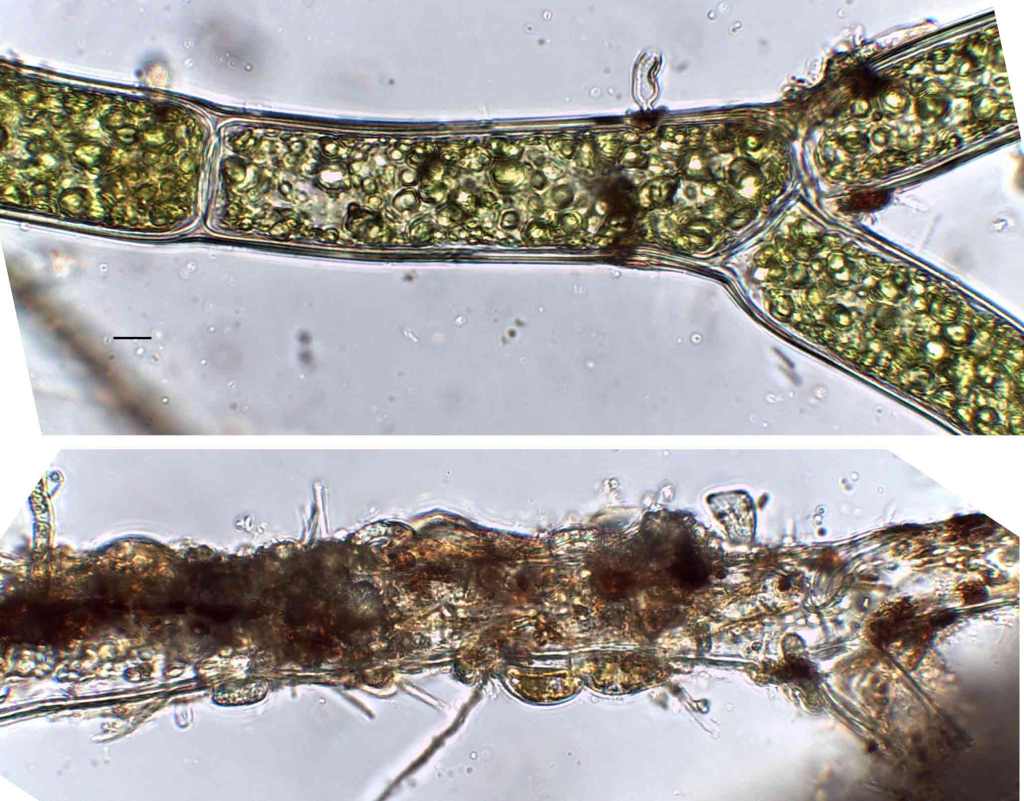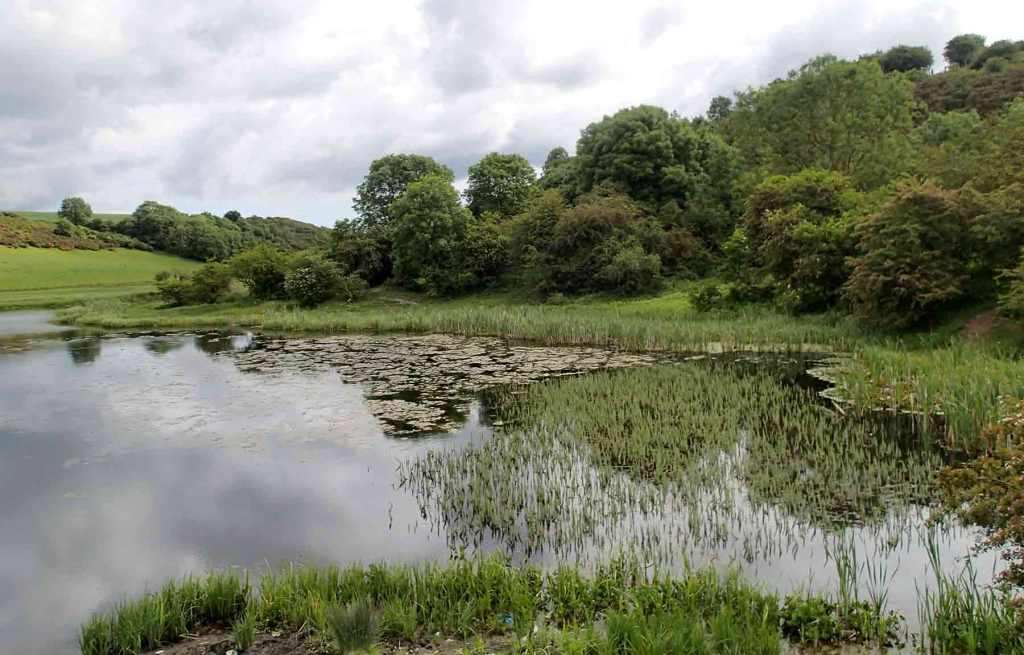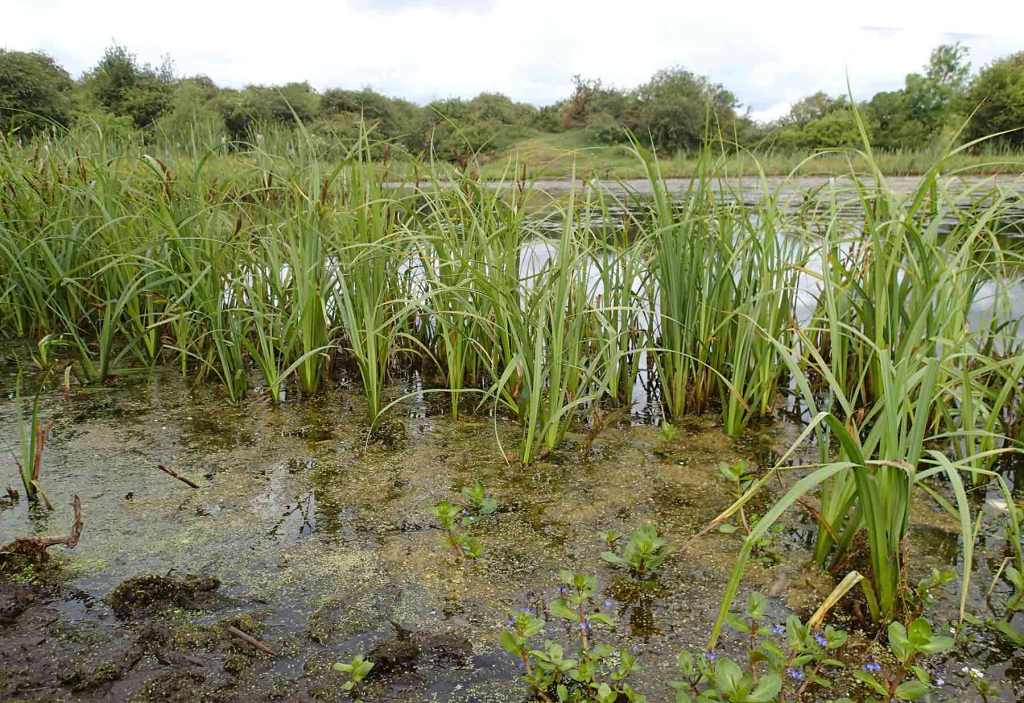It seems like a long while since I have written about Cassop Pond (see “Cassop Pond in May”). As earlier posts have shown, a lot can happen between two visits, so I was curious to see what had changed. One of the leitmotifs of this blog is that you can never know the algae in any habitat from a single visit: you need to go back in different seasons to understand how they change. Even then, you end up with a picture of how they change over the course of a single year, without any absolute guarantee that the same patterns will repeat in future years. A sample or an observation, in other words, represents a point in space and time. More than that, it represents a decision on the part of the observer. Even a small pond such as this (only 0.36 hectares, according to the Environment Agency’s Catchment Data Explorer) has myriad habitats that could be explored by a microscopist.
My June visit took me back to the flocs of the aquatic liverwort, Riccia fluitans, that I wrote about in Working their passage, and illustrated in Pond Politics. These flogs are still prolific in the margins, and often share the habitat with duckweed, Lemna minor. However, my June samples also showed a considerable quantity of blanket weed, Cladophora glomerata, entwined amongst the Riccia fronds. These were definitely not prolific when I last looked, but that was three months ago and the warmer weather we’ve had since then will have encouraged growth of Cladophora.
There were some typical branched filaments of Cladophora in a healthy state and relatively free of epiphytes; however, there were also many dead or decaying filaments smothered in epiphytes. This is quite unusual, as Cladophora can normally support large populations of epiphytes without appearing to suffer. Moreover, most of the epiphytes that I could see were Epithemia sorex, the nitrogen-fixing diatom which I wrote about in Working their passage. I’ve not seen this species growing directly on Cladophora before either.

Cladophora glomerata often takes over a habitat, living up to its common name of “blanket weed”. I’m wondering if, in this particular habitat at this time of year, it has met its match. There is evidence in the literature of Cladophora growth being limited by nitrogen, which probably says more about the diversity of habitats within which Cladophora is found than being a fundamental truth about Cladophora itself. What we can say is that, rather than being the insidious “weed” that blights so many rivers and ponds, it seems to be a distant third, after Riccia fluitans and Epithemia sorex, in the race for dominance at Cassop Pond.
That, too, gets me intrigued to see what will have happened next time I visit Cassop. If it is so clearly losing in the struggle to acquire nutrients in June then, maybe, it will have disappeared in July. Then again, maybe conditions will have changed and it will have surged past Riccia fluitans and Epithemia. Who knows?
References
Lohman, K. and Priscu, J.C. (1992). Physiological indicators of nutrient deficiency in Cladophora(Chlorophyta) in the Clark Fork of the Columbia River Montana. Journal of Phycology 28: 443-448.
Millner, G.C., Sweeney, R.A. & Frederick,V.R. (1982). Biomass and distribution of Cladophora glomerata in relation to some physical-chemical Variables at two sites in Lake Erie. Journal of Great Lakes Research 8: 35-41.
Some other highlights from this week:
Wrote this whilst listening to: Floating Point with Pharoah Sanders and the London Symphny Orchestra collaboration Promises. Intriguing blend of electronica/ambient, jazz and classical music.
Cultural highlights: Enjoying the Channel 4 comedy series This Way Up, starring Aisling Bea.
Currently reading: Fortress Plant by Dale Waters. A fairly stolid description of the many ways that higher plants repel grazers and pathogens. And rereading John Bunyan’s Pilgrim’s Progress.
Culinary highlight: Has to be fish and chips in Tynemouth, sitting on a bench overlooking the beach. Celebrating (in reverse order) my youngest son’s release from quarantine and completion of his philosophy degree.



Pingback: Change of tenants … – microscopesandmonsters